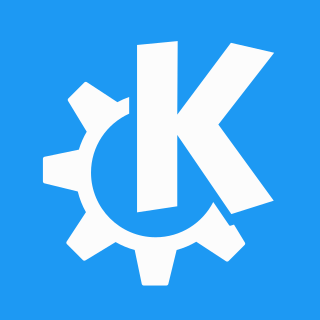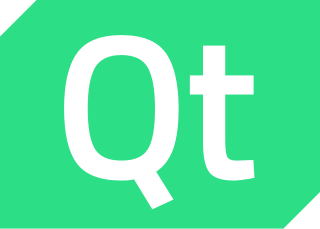
KDE is an international free software community that develops free and open-source software. As a central development hub, it provides tools and resources that allow collaborative work on this kind of software. Well-known products include the Plasma Desktop, KDE Frameworks, and a range of cross-platform applications such as Amarok, digiKam, and Krita that are designed to run on Unix and Unix-like operating systems, Microsoft Windows, and Android.

Calligra Suite is a graphic art and office suite by KDE. It is available for desktop PCs, tablet computers, and smartphones. It contains applications for word processing, spreadsheets, presentation, databases, vector graphics, and digital painting.

Calligra Words is a word processor, which is part of Calligra Suite and developed by KDE as free software.

Qt is cross-platform application development framework for creating graphical user interfaces as well as cross-platform applications that run on various software and hardware platforms such as Linux, Windows, macOS, Android or embedded systems with little or no change in the underlying codebase while still being a native application with native capabilities and speed.

Kexi is a visual database applications creator tool by KDE, designed to fill the gap between spreadsheets and database solutions requiring more sophisticated development. Kexi can be used for designing and implementing databases, data inserting and processing, and performing queries. It is developed within the Calligra project but is released separately.

Krita is a free and open-source raster graphics editor designed primarily for digital art and 2D animation. Originally created for Linux, the software also runs on Windows, macOS, Haiku, Android, and ChromeOS, and features an OpenGL-accelerated canvas, colour management support, an advanced brush engine, non-destructive layers and masks, group-based layer management, vector artwork support, and switchable customisation profiles.

Maemo is a software platform originally developed by Nokia, now developed by the community, for smartphones and Internet tablets. The platform comprises both the Maemo operating system and SDK. Maemo played a key role in Nokia's strategy to compete with Apple and Android, but ultimately failed to surpass both companies.Maemo is mostly based on open-source code and has been developed by Maemo Devices within Nokia in collaboration with many open-source projects such as the Linux kernel, Debian, and GNOME. Maemo is based on Debian and draws much of its GUI, frameworks, and libraries from the GNOME project. It uses the Matchbox window manager and the GTK-based Hildon framework as its GUI and application framework.

Kugar is a discontinued tool for generating business quality reports for KOffice. The reports can be viewed and printed. It includes a standalone report viewer and a KParts report viewer. The latter means that any K Desktop Environment 3 application can embed the report viewing functionality and that reports can be viewed using the Konqueror browser.

KDE Plasma 4 is the fourth generation of the KDE workspace environments. It consists of three workspaces, each targeting a certain platform: Plasma Desktop for traditional desktop PCs and notebooks, Plasma Netbook for netbooks, and Plasma Active for tablet PCs and similar devices.
Kross is a scripting framework for KDE Frameworks. Originally Kross was designed for use in KOffice but eventually became the official scripting framework in KDE Software Compilation 4. Kross is designed to provide full scripting power for users of KDE applications, with a language of their own choice; and make it easy for developers targeting the KDE platform to enable their application with support for multiple scripting languages.
Flake or a Vector Shape is a programming library that is used in Calligra Suite and the KOffice 2 series. Flake provides the basic concept of a "shape". To the end user a shape appears as some piece of content such as an image or a text. A shape can be in any form and contain any kind of media since the Shape is responsible for drawing itself. All components of KOffice are being overhauled to use Flake as much as possible.

K Desktop Environment 2 was the second series of releases of the K Desktop Environment. There were three major releases in this series.

Calligra Plan is a project management application that can create Gantt-style charts and is part of Calligra Suite – formerly included with KOffice.

MeeGo is a discontinued Linux distribution hosted by the Linux Foundation, using source code from the operating systems Moblin and Maemo. MeeGo was primarily targeted at mobile devices and information appliances in the consumer electronics market. It was designed to act as an operating system for hardware platforms such as netbooks, entry-level desktops, nettops, tablet computers, mobile computing and communications devices, in-vehicle infotainment devices, SmartTV / ConnectedTV, IPTV-boxes, smart phones, and other embedded systems.

KOffice was a free and open source office and graphics suite developed by KDE for Unix-like and Windows systems. KOffice contains a word processor (KWord), a spreadsheet (KSpread), a presentation program (KPresenter), and a number of other components that varied over the course of its development.

KWord is a deprecated word processor and a desktop publishing application, part of the KOffice suite. It has been obsoleted by Calligra Words of the Calligra Suite.

Jolla Oy is a Finnish technology company; vendor and developer of Sailfish OS. Headquartered in Tampere, Finland, Jolla has its own research and development offices in Helsinki, Tampere and Cyberport, Hong Kong. Jolla was founded in 2011 by former Nokia staff of the MeeGo project team to use the MeeGo opportunities and its "endless possibilities".

The KDE Gear is a set of applications and supporting libraries that are developed by the KDE community, primarily used on Linux-based operating systems but mostly multiplatform, and released on a common release schedule.

KDE Projects are projects maintained by the KDE community, a group of people developing and advocating free software for everyday use, for example KDE Plasma and KDE Frameworks or applications such as Amarok, Krita or Digikam. There are also non-coding projects like designing the Breeze desktop theme and iconset, which is coordinated by KDE's Visual Design Group. Even non-Qt applications like GCompris, which started as a GTK-based application, or web-based projects like WikiToLearn are officially part of KDE.
















